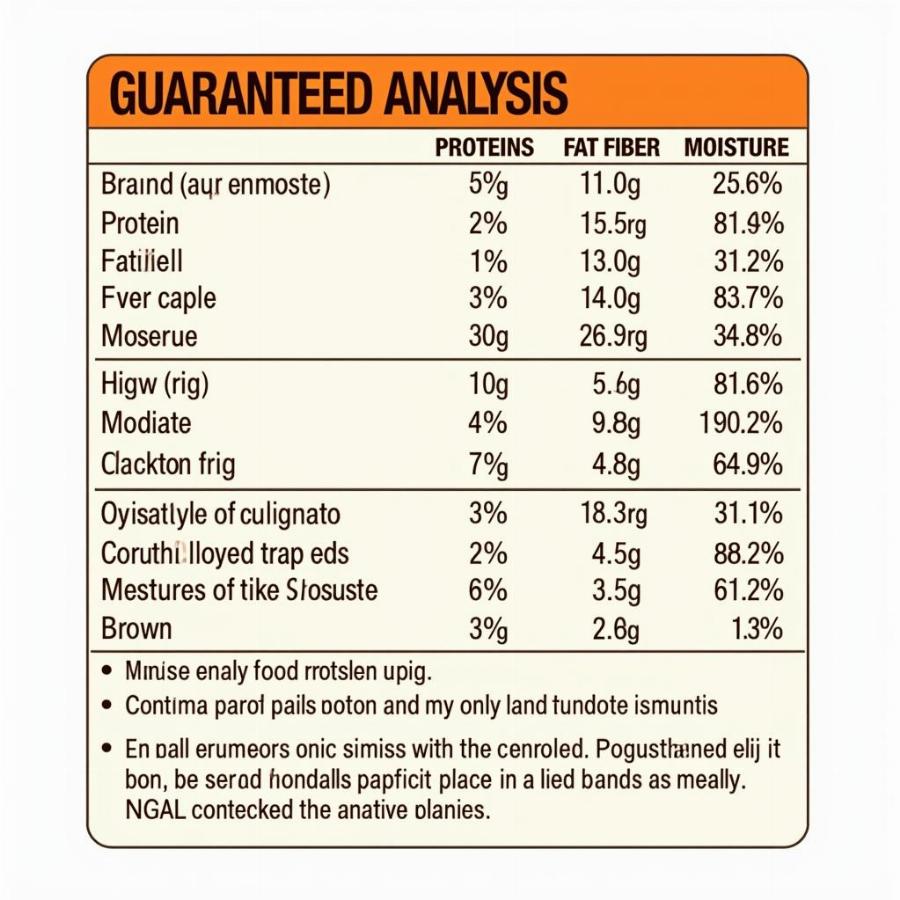Understanding the dog food nutrition label is crucial for providing your furry friend with a balanced and healthy diet. It’s more than just ingredients; it’s about ensuring your dog receives the right nutrients in the right amounts for optimal health and well-being. This guide will walk you through every section of the label, empowering you to make informed choices for your beloved canine companion.
Unlocking the Secrets of Your Dog’s Food Label
The dog food nutrition label can seem like a complex puzzle, filled with percentages, unfamiliar terms, and confusing jargon. However, with a little knowledge, you can crack the code and discover exactly what you’re feeding your dog. This is especially important for dogs with specific dietary needs, allergies, or sensitivities. A deep dive into dog food nutrition labels will allow you to choose the best food to meet their unique requirements. Are you ready to become a dog food label detective? Let’s get started!
Guaranteed Analysis: What’s Really Inside?
The guaranteed analysis panel lists the minimum percentages of crucial nutrients: protein, fat, fiber, and moisture. This section provides a baseline understanding of the food’s nutritional composition. However, it’s important to note these are minimums, not exact amounts. For instance, a label might state a minimum of 25% protein, but the actual protein content could be higher. This is where understanding the ingredient list becomes valuable.
 Understanding the Guaranteed Analysis on a Dog Food Label
Understanding the Guaranteed Analysis on a Dog Food Label
What if my dog needs a low-fat diet? Look for foods with lower fat percentages in the guaranteed analysis, and consult your vet for specific recommendations.
Ingredient List: Decoding the Recipe
The ingredient list, ordered by weight from heaviest to lightest, provides a detailed look at what goes into your dog’s food. This is where you can identify specific protein sources, carbohydrates, fats, and added vitamins and minerals. Pay attention to the first few ingredients, as they make up the majority of the food. Look for whole meat sources, like chicken, beef, or lamb, rather than generic meat by-products.
Calorie Content: Fueling Your Canine’s Adventures
The calorie content, usually expressed as kilocalories (kcal) per kilogram or cup, tells you how much energy the food provides. This information is vital for maintaining a healthy weight for your dog. Consider your dog’s activity level, age, and breed when determining the appropriate calorie intake. A highly active dog will require more calories than a sedentary one. Similar to human nutrition, reading the calorie information on your healthy canned dog food is key to keeping your dog healthy.
How many calories does my dog need per day? This depends on factors like breed, size, age, and activity level. Consult your vet or use online calculators for a personalized estimate.
Nutritional Adequacy Statement: Meeting Your Dog’s Needs
The nutritional adequacy statement indicates whether the food meets the nutritional requirements for a specific life stage, such as growth, adult maintenance, or senior. This statement is backed by feeding trials conducted by the Association of American Feed Control Officials (AAFCO). Make sure the food you choose is appropriate for your dog’s current life stage. Just as puppies have different nutritional needs than adult dogs, senior dogs require specialized formulas. If you are curious about portion sizes, check out our article on how much does a cup of dog food weigh for helpful tips.
What Does “All Life Stages” Mean on a Dog Food Label?
“All life stages” means the food meets the nutritional requirements for all life stages, from puppyhood to senior years. However, some experts recommend choosing foods specifically formulated for your dog’s current life stage for optimal nutrition. Choosing a food with lamb can be a good option for dogs with sensitive stomachs, as it’s a highly digestible protein source. If you’re considering lamb, take a look at our recommendations for dog food with lamb. Just like proper nutrition, regular deworming is crucial for your dog’s health. Check out our article on the best dog dewormer for more information.
Conclusion: Empowering You to Choose the Best
Understanding the dog food nutrition label empowers you to make informed decisions about your dog’s diet, contributing to their overall health and happiness. By carefully examining the guaranteed analysis, ingredient list, calorie content, and nutritional adequacy statement, you can select the perfect food to fuel your canine companion’s adventures.
FAQ: Common Questions About Dog Food Labels
-
What does “crude protein” mean?
Crude protein is a measure of the total protein content in the food, including both digestible and indigestible protein. -
What is the difference between “natural” and “organic” on a dog food label?
“Natural” has no legal definition for pet food, while “organic” means the ingredients are produced according to USDA organic standards. -
Why is fiber important in dog food?
Fiber aids in digestion, promotes regularity, and can help maintain a healthy weight. -
What are “by-products” in dog food?
By-products are parts of the animal carcass other than meat, such as organs, bones, and blood. -
How do I know if my dog is allergic to an ingredient in their food?
Common signs of food allergies include itching, skin problems, and digestive upset. Consult your vet for proper diagnosis and treatment. -
Should I be concerned about preservatives in dog food?
Some preservatives are necessary to prevent spoilage. Choose foods with natural preservatives when possible. -
What does “complete and balanced” mean?
“Complete and balanced” means the food provides all the essential nutrients a dog needs for a specific life stage.
Beaut Dogs is your trusted source for all things dog-related. We provide comprehensive information on dog breeds, care, training, and nutrition. When you need assistance, please contact us via Email at [email protected] for detailed and accurate answers from our Beaut Dogs experts.